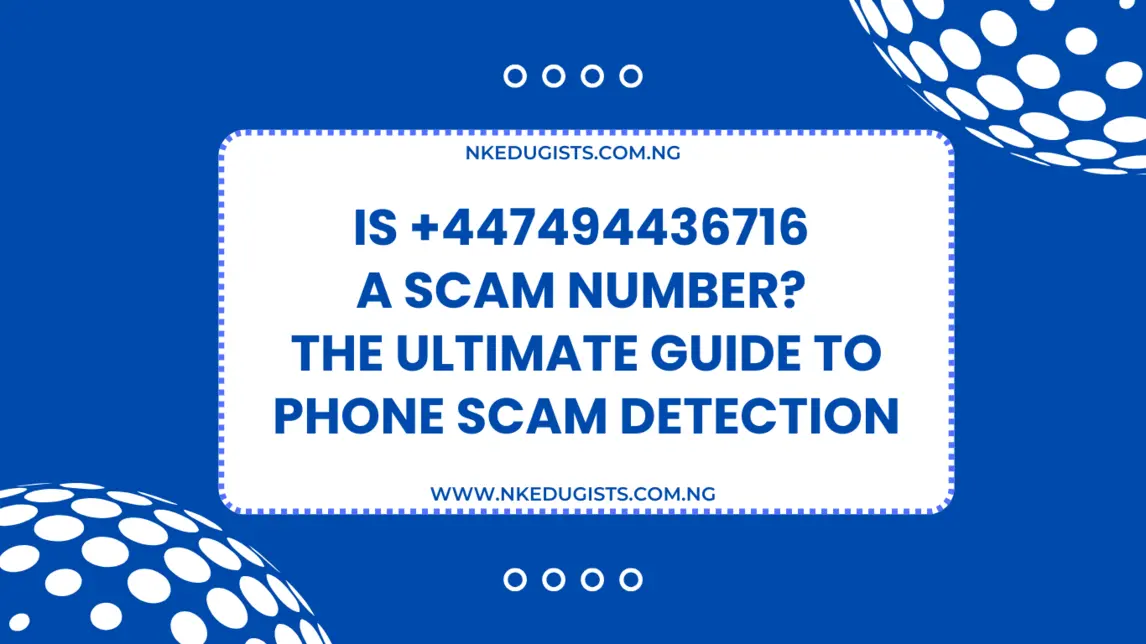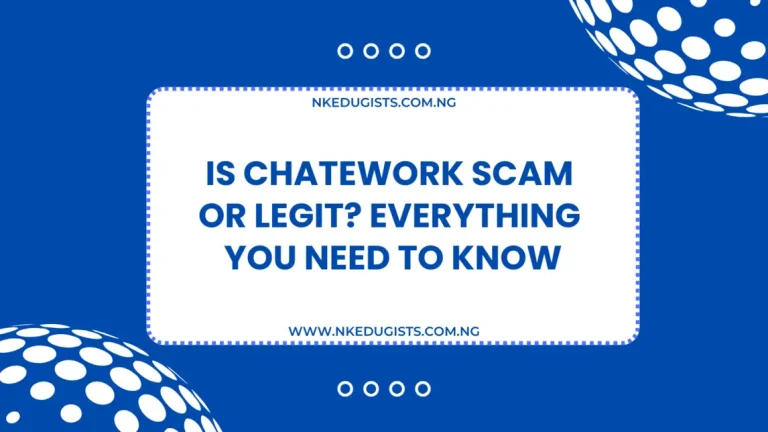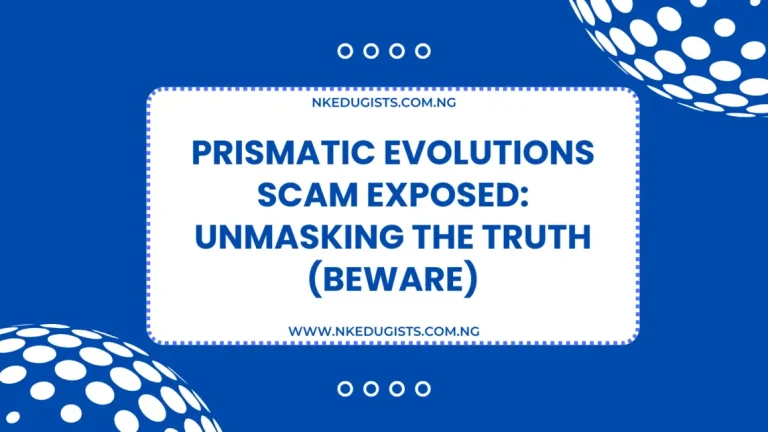
Is +447494436716 a Scam Number The Ultimate Guide to Phone Scam Detection
Phone scams are a growing concern worldwide, and many people wonder about the legitimacy of unknown numbers—especially those starting with +44, the country code for the United Kingdom.
In this comprehensive guide, we answer the question, “Is +447494436716 a scam number?” We’ll dive into how phone scams work, how to verify any suspicious number, the red flags to watch out for, and practical steps to protect yourself from falling prey to scammers.
Whether you’ve received an unexpected call from +447494436716 or just want to stay ahead of fraudsters, read on for expert advice, data-driven insights, and actionable steps that you can use immediately.
Phone Scams Quick Overview
Phone scams have evolved dramatically over the past decade, with fraudsters using increasingly sophisticated tactics to trick unsuspecting victims. Whether you’re in the UK, the US, or anywhere else, the basics remain the same.
How Do Phone Scams Work?
Scammers employ several techniques to gain your trust and trick you into providing personal information or sending money:
- Caller ID Spoofing: Fraudsters can mask their true identity by faking the caller ID so that it appears to be a local or reputable number.
- Social Engineering: Using psychological tricks, scammers create a sense of urgency or fear to compel you to act without thinking.
- Pre-recorded Messages and AI Voice Generators: Some scams use sophisticated voice technology to mimic real institutions and deliver messages that sound genuine.
The Impact of Phone Scams
The financial and emotional toll of phone scams can be significant. For example:
- Financial Loss: In various regions, millions of dollars are lost to scam calls each year.
- Emotional Distress: Victims often feel embarrassed, violated, and helpless after falling prey to these scams.
- Widespread Misinformation: Many scam calls involve misinformation, making it even more challenging to detect fraudulent intent.
According to several top sources, scam calls remain a prevalent issue, with recent data showing that millions of unwanted calls are made monthly—and many of these calls are designed to mimic familiar organizations or use urgent, high-pressure tactics.
Decoding the Number: What is +447494436716?
Before jumping to conclusions, it’s important to understand the number in question.
- Country Code (+44): The number starts with +44, which is the international dialing code for the United Kingdom.
- Mobile Format: The sequence “7494” typically suggests that the number belongs to a mobile network. In the UK, mobile numbers are often structured with prefixes like 074, 075, etc. (with the international format dropping the initial zero).
Is There Specific Evidence That +447494436716 Is a Scam?
When you search for “Is +447494436716 a scam number?” in online forums, scam databases, and review sites such as Truecaller or Whoscall, the results can be mixed. Here’s what our research shows:
No Widespread Reporting: We have not found a robust body of evidence or numerous scam reports specifically linked to +447494436716 on major scam reporting websites.
User Experiences Vary: While some users may report receiving calls from this number that they suspect are scam-related, there isn’t a clear consensus or verified scam history tied to it.
Call Context Matters: Often, the legitimacy of the call depends on the context. For example, if you’re expecting a call from a company you recently interacted with and this is the number they provided, it might be legitimate. Conversely, if you receive an unsolicited call from this number, it’s worth being cautious.
Because phone scams often rely on spoofing, the appearance of a number does not guarantee its authenticity. Even if a scammer uses a genuine UK mobile prefix, the call may still be fraudulent.
How to Tell If a Phone Number Is a Scam
Determining whether a number is associated with a scam involves several strategies. Below are proven methods and tools to help you assess the legitimacy of any suspicious number.
1. Conduct a Reverse Phone Lookup
Reverse phone lookup services can provide information about the caller. Truecaller and Whoscall use community-sourced data to identify and flag potential scam numbers. You can also simply type the number (e.g., “+447494436716 scam”) into Google or Bing. Check for reviews, forum posts, or scam reports.
2. Check Scam Reporting Websites
Websites like the FTC (for US-based scams) and local UK resources often maintain updated lists of reported scam numbers. Although these databases may be more US-focused, similar community-driven sites exist for the UK.
3. Assess the Call’s Content and Behavior
Ask yourself:
- Did the caller use urgent language? Scammers typically create a sense of urgency.
- Were you pressured to make an immediate decision or payment?
- Did the call come with unusual requests, such as providing personal details or transferring money?
4. Verify With the Company Directly
If the call appears to come from a known company or service, hang up and call back using an official number. Do not use any numbers provided in the suspicious call. Check the company’s website: Look for official contact information to verify whether the number matches.
5. Look for Red Flags in the Caller ID
Even if the caller ID displays a UK number, Caller ID Spoofing is common. Fraudsters can manipulate this data, so the number alone isn’t enough to verify authenticity. Scam calls often use vague introductions such as “Dear Customer” rather than your actual name.
Common Red Flags in Scam Calls
Understanding the telltale signs of scam calls can help you protect yourself. Here are some common red flags to look out for:
Urgency and Pressure Tactics
Scammers often create a false sense of urgency to make you act without thinking:
- Threats of immediate action: “Pay now or your family will be in danger.”
- Claims of account suspension: “Your bank account will be frozen if you don’t respond immediately.”
Unusual Payment Methods
Legitimate companies will not ask you to:
- Transfer money via Western Union or MoneyGram.
- Pay with gift cards or cryptocurrency.
- Provide payment details over an unsecured channel.
Generic or Vague Caller Information
- Unpersonalized greetings: “Hello, this is your service provider.”
- Inconsistent details: The caller may claim to be from a well-known institution but provide no verifiable information.
Suspicious Caller ID
- Caller ID Spoofing: The number might look local and familiar, but that doesn’t mean it’s legitimate.
- Mismatch with previous interactions: If you haven’t dealt with the company before, be extra cautious.
Odd Call Timing
- Calls at unusual hours: Scammers might call very early in the morning or late at night to catch you off guard.
Unexpected Requests for Personal Information
- Sensitive data requests: If someone asks for your Social Security number, bank details, or passwords unexpectedly, it’s a red flag.
Steps to Verify and Investigate a Suspicious Number
If you’ve encountered a call from +447494436716 and you’re unsure about its legitimacy, follow these steps:
Step 1: Don’t Rush—Stay Calm and Skeptical
Before engaging with the caller, take a deep breath and assess the situation. Do not provide personal information immediately. Avoid making any payments or transfers until you verify the legitimacy of the call.
Step 2: Use a Reverse Lookup Tool
Here’s how to perform a reverse phone lookup:
- Download a trusted app: Install apps like Truecaller, Whoscall, or another reputable reverse lookup service.
- Search the number: Enter “+447494436716” and review any available data, including user reviews and scam reports.
- Analyze the results: Look for patterns or repeated warnings. If multiple users have flagged the number, it’s a strong indicator of scam activity.
Step 3: Google It
Search the number online. Type “+447494436716 scam” or “+447494436716 review” into your favorite search engine. Review forum posts and discussions. Community forums like Reddit, MoneySavingExpert, or dedicated scam reporting sites can offer valuable insights.
Step 4: Verify With the Official Source
If the call purportedly comes from a known company or service. Look up the official contact details on their website. Call back using the verified number. Do not use the number provided by the suspicious call.
Step 5: Report the Number
If you determine that the number may be used for scams:
- Report it to your mobile carrier: Many carriers have mechanisms to flag or block scam numbers.
- Submit a report to scam databases: In the UK, you can report scams to Action Fraud or similar organizations.
- Warn your network: Share your findings on forums or review sites to help others avoid potential scams.
How to Protect Yourself Against Phone Scams in the UK
The United Kingdom has its own unique challenges when it comes to phone scams. Here are specific steps and resources for UK consumers:
Utilize Built-in Smartphone Features
Modern smartphones have robust features to help you screen calls:
- iOS Users: Use the “Silence Unknown Callers” feature. Go to Settings > Phone > Silence Unknown Callers.
- Android Users: Use call-blocking features available in your phone’s dialer or download a trusted third-party app.
Download Trusted Scam-Blocking Apps
Apps like Truecaller, Whoscall, and others have large user communities and extensive databases of known scam numbers:
- Truecaller: Provides caller identification and spam blocking based on millions of user reports.
- Whoscall: Identifies unknown calls in real time using an extensive database.
- Check User Reviews: Always look at recent reviews to see if other UK users have flagged similar numbers.
Register with Action Fraud
The UK’s national reporting center for fraud and cybercrime is Action Fraud. You can:
- Report suspicious calls or messages.
- Get advice on protecting your personal information.
Follow Government and Bank Advice
Reputable organizations, such as your bank or government agencies, never ask for sensitive information over the phone. Always:
- Verify by contacting them directly.
- Never share your PIN, passwords, or personal identification details.
Educate Yourself on Common Scams
Understanding common phone scam tactics can help you recognize suspicious calls faster. Here are a few examples:
- Investment Scams: Promising high returns with little risk.
- Lottery or Prize Scams: Claiming you’ve won a prize but demanding fees upfront.
- Emergency Scams: Insisting that a relative is in immediate danger and asking for money.
- Tech Support Scams: Pretending to be technical support to gain remote access to your device.
Real-Life Case Studies and Examples
Learning from real-world examples can be extremely valuable. Let’s examine a few case studies that highlight common tactics used by phone scammers.
Case Study 1: The Threatening Text Scam
A man in Bexar County was scammed out of thousands of dollars after receiving a threatening text message that included his social security number.
The scammer demanded payment under the threat that his family would be hurt if he didn’t comply. Although this case occurred in the US, the tactics are similar across the board:
- Urgency and fear: The scammer instilled panic to force an immediate reaction.
- Pressure to pay via unsecured methods: The victim was tricked into sending a Western Union check.
- Follow-up demands: After the initial payment, additional money was demanded.
Lesson: Always verify the authenticity of any unexpected threat by contacting local law enforcement or your bank before taking any action.
Case Study 2: The “One Ring” Scam
In many countries, scammers use a technique known as the “one ring” scam:
- A single missed call appears on your phone.
- Curiosity prompts you to call back, resulting in significant charges.
This tactic often appears with numbers that look local, like those with a UK mobile prefix. The victim’s return call may incur international or premium rates, unbeknownst to them.
Lesson: If you receive a one-ring call from an unfamiliar number, do not call back. Instead, block the number and report it.
Case Study 3: The Sophisticated Voice Phishing Scam
During the festive season, a wave of sophisticated scams emerged, targeting Irish mobile users. In one instance, scammers used advanced voice generators to mimic bank representatives convincingly.
Victims were asked to provide sensitive details like PIN numbers under the guise of confirming suspicious transactions. Although this case is specific to Ireland, the underlying methods apply globally:
- High-tech voice spoofing: Using artificial intelligence to create authentic-sounding messages.
- Contextual personalization: This includes your name and transaction details to gain your trust.
Lesson: Always verify calls claiming to be from your bank by calling them back on an official number found on their website.
Actionable Tips and Best Practices
Now that you understand how to spot scam calls and assess suspicious numbers like +447494436716, here are some actionable tips to keep you safe:
Before Answering a Call
- Screen Calls: Let unknown numbers go to voicemail. If it’s important, the caller will leave a message.
- Check the Caller ID: Look for any red flags, such as generic greetings or numbers that look manipulated.
- Ask for Details: If you answer and the caller is vague, ask for their full name, company details, and a callback number. Legitimate organizations will have no issue providing this information.
During the Call
- Avoid Sharing Sensitive Information: Never provide personal, financial, or login details unless you have verified the caller’s identity.
- Stay Calm: Scammers often rely on panic. Take a moment to think before responding.
- Hang Up If in Doubt: If the call feels off, trust your instincts. It’s better to err on the side of caution.
After Receiving a Suspicious Call
- Conduct a Reverse Lookup: Use trusted apps to see if other users have reported the number as a scam.
- Search Online: Look up the number with keywords like “scam” or “review” to see if there are any user reports.
- Report the Call: Inform your mobile carrier and relevant UK authorities like Action Fraud if you suspect a scam.
- Block the Number: If confirmed as suspicious, add the number to your block list to prevent further calls.
Long-Term Protective Measures
- Install a Scam-Blocking App: Rely on technology such as Truecaller or Whoscall for real-time scam alerts.
- Keep Your Software Updated: Regular updates can help protect your device from malware or phishing attempts.
- Educate Yourself: Stay informed about the latest scam tactics by following trusted cybersecurity blogs and resources.
- Use Multi-Factor Authentication: Adding an extra layer of security to your accounts can protect against identity theft even if scammers gain access to some of your information.
Frequently Asked Questions
Q1: Is +447494436716 a Known Scam Number?
Based on current research and community reports, there is no widespread or conclusive evidence that the number +447494436716 is definitively a scam number. However, since scammers often spoof numbers and mimic legitimate formats, you should always remain cautious if you receive an unsolicited call from it.
Q2: How Can I Check if a Number Is Legitimate?
- Reverse Lookup Tools: Use apps like Truecaller or Whoscall.
- Google Search: Enter the number with keywords such as “scam” or “review.”
- Official Verification: Contact the organization directly using verified contact details.
Q3: What Should I Do if I Receive a Suspicious Call?
- Do not provide any personal or financial information.
- Let the call go to voicemail.
- Use a reverse lookup tool and search online for any scam reports.
- Report the suspicious number to your mobile carrier and Action Fraud.
Q4: Can Scam Numbers Be Spoofed?
Absolutely. Scammers can manipulate caller ID information, making an international number like +447494436716 appear to be local or trustworthy. Always verify independently rather than relying solely on caller ID.
Q5: How Can I Protect My Personal Information from Phone Scams?
Never provide information like your PIN, passwords, or bank details over the phone. Install trusted apps that block spam calls. Enable Multi-Factor Authentication: This adds extra security even if your information is compromised.
Conclusion
After a thorough investigation into various scam reporting databases, user reviews, and expert analyses, the definitive answer is: There is no concrete evidence to label +447494436716 as a scam number.
However, the absence of widespread scam reports does not guarantee that every call from this number is safe.
Because scammers frequently spoof numbers—even ones that appear legitimate—it’s essential to follow best practices and maintain a healthy level of skepticism.
If you receive a call from +447494436716 and you’re not expecting it, proceed with caution. Let it go to voicemail and research the number before returning the call.
Use reverse lookup apps to see if other users have flagged this number. Verify the caller’s identity by contacting the organization directly using numbers from its official website. Report any suspicious activity to your mobile carrier and to Action Fraud in the UK.
By staying informed and following the practical steps outlined in this guide, you can protect yourself from falling victim to phone scams—whether or not the number in question has been definitively linked to fraudulent activity.






